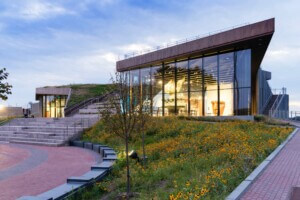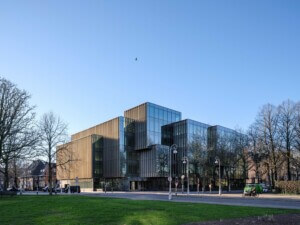The month of July was the hottest ever recorded. Carbon emissions are directly linked to rising temperatures, weather pattern disruption, and wildfires such as those that kept a third of the U.S. population under air quality restrictions last month. Can the emergence of responsible designs and solutions improve this situation? Recently, innovations in glass and glazing technologies have been used to strike a balance between the development of new technologies and more holistic, circular practices.
At the Glass Performance Days (GPD) conference, held in Tampere, Finland, in June 2023, a collaborative of practitioners participated in a workshop called “Clarity Revisited, (Re)shaping the Future of Glass.” Part of a one-day event called Opportunities in a Circular Economy for the Glazing Industry, this workshop brought competitors from the industry together to brainstorm new paths forward, honestly addressing the climate crisis and designers’ roles within it. While most of the environmental impact of facades is related to energy preservation, this group focused on embodied carbon emissions related to the fabrication of glazing products. Here are some of the most important takeaways from this working group.

Energy
The amount of energy and its source (renewable or nonrenewable) in the manufacturing process of glass significantly influences the extent of environmental impact. This is highly relevant for the most intensive stages of production, like the float process, which occurs before cutting and processing of glass. These issues are deeply entrenched and therefore difficult to change, but by directly engaging questions of emissions related to primary energy use, we can unlock the highest potential for carbon reduction.
Some successful strategies we discussed as models for future innovation included ongoing work to decentralize energy supply systems. By partially diversifying kiln combustion strategies, implementing recover heat from industry processes, installing photovoltaic panels wherever relevant, and educating all stakeholders about the carbon intensity and design/procurement implications of each relevant step, contractors and designers alike will have more power to designate more responsible standards.
Material Recovery Systems
The use of secondary resources, such as glass cullet—recycled glass sorted based on color—is a great avenue to reduce the melting temperature of glass and thus reduce emissions. In fact, the incorporation of post- and preconsumer glass cullet decreases the emissions related to the production of float glass. (One ton of cullet saves approximately 0.3 tons of CO2.)
However, finding efficient ways to harvest postconsumer flat glass is the leading priority for the industry right now, especially in the flat-glass sector, where these circular practices are not currently common. This would mean that recycling companies would both collect and sort cullet. But it’s become clear that more specialist dismantlers are necessary to upscale glass reuse and recycling. They also need to be brought into all stages of design development to determine whether today’s designs can be dismantled in the future.
A robust network for glass reuse and recycling could have a massive impact on material life cycles and carbon sequestration, as we know from sophisticated standards in metal reprocessing, for example. But the reusability of glass generally can also be aided by secondary products that can be considered at the time of manufacturing and fabrication. Certain surface sealants and treatments make reuse more feasible for our existing systems: For example, Cutri and Willareth shared recently published research into the reuse of glass in spandrels at GPD that can be aided by the use of full-face sealant, which creates a “safety glass” for at least one more design cycle. Even partially circular considerations and solutions are helping reduce carbon emissions now, which is key to meet Paris Agreement goals.
Data and Communication
Fortunately, the environmental data for flat-glass products is growing and increasingly accessible. New products typically have tags or can be equipped with “chips”—sensors that collect data on glazing performance and also store information about where a product was manufactured, by whom, and other specifics that would be important to the next user to know when recycling the material. However, there is untapped potential for even more dynamic technology: For example, using AI to map existing buildings and tag data is currently being researched. Also, communication between clients and designers about environmental qualities and impacts is improving along with awareness, a trend we hope to continue to see.

Design for Disassembly
It’s widely recognized that flat-glass products are attractive targets for disassembly efficiency research. It’s merely a matter of time and tool selection. Equipment solutions are available to deglaze facade products and prepare glass for recycling. By developing dismantling processes and design strategies amiable to recycling or reuse, architectural glass will have more potential to stay within the same market and therefore contribute to its decarbonization.
It is very promising to see that several insulating glass unit (IGU) manufacturers and glazers have developed processes and equipment solutions to take apart existing units, clean the glass, and reform a new IGU. This process, has precedents around the world, including examples in Belgium, the Netherlands, Quebec, and New York City.
But how can practitioners and fabricators enter into discourse about these necessary changes? To support much-needed new collaborations, new platforms for data sharing and material repurposing are needed, though a few already exist in the U.S. and Europe. But beyond building these new platforms, it’s important to also support new generations of planners and engineers from diverse backgrounds. By diversifying the field, we redefine the role of designers as leaders in new bidding and supply chain management efforts. Today, universities are developing circularity courses and programs as part of architectural education: Gone are the days where architecture was seen as a formal exercise devoid of real-world responsibility.
To be not only relevant, but a leader in addressing the climate emergency, the glass industry (including all stakeholders in the entire design and construction process) must nevertheless aim to perform outside of merely using more glass. Project-specific questions must be asked that tailor innovation to the appropriateness of a site. Sustainability must be embedded in a project from the very beginning, from concept all the way to the detailing and fabrication phase. Designers today must ask: What is the whole life carbon of my glass facade design and operation? Is an ultrahigh thermal performance, floor-to-ceiling, transparent glass box a responsible design? Is low-iron glass necessary? How can I design with reused/recycled glass in facades while still delivering high thermal performance? These considerations will yield new design dynamics and aesthetics and certainly whole new architectures.
Sophie Pennetier, associate director of special projects, steers Enclos’s growing sustainability and circularity efforts. She is an adjunct professor at SCI-Arc and involved in several industry focus groups aimed at decarbonizing facades, such as the Facade Tectonics Institute, where she serves on the board of directors.
Lisa Rammig leads the teams in Eckersley O’Callaghan’s California offices. She has played a significant role in its expansion, leading many of the group’s most challenging projects, while also remaining involved in academia and building strong links between research and industry. She is part of the Facade Research Group at TU Delft and is an elected member of the Special Advisory Council of the Facade Tectonics Institute at the University of Southern California.
Linda Hildebrand is a professor of reuse in architecture at RWTH Aachen University. She is an architect specialized on circularity in the built environment and a cofounder of Concular, a platform for digital services to facilitate circularity in the built environment.











